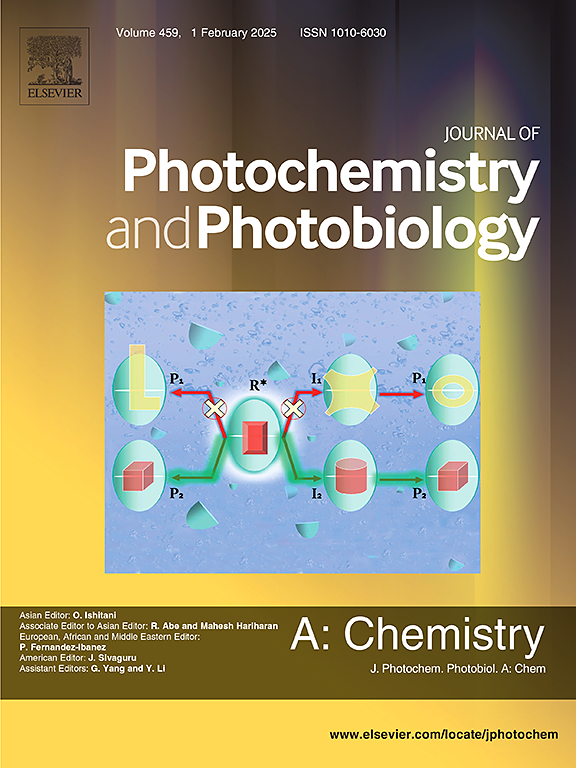红橙色发光热稳定Sm3+掺杂Sr2LaSbO6荧光粉应用于w- led
IF 4.1
3区 化学
Q2 CHEMISTRY, PHYSICAL
Journal of Photochemistry and Photobiology A-chemistry
Pub Date : 2025-04-10
DOI:10.1016/j.jphotochem.2025.116405
引用次数: 0
摘要
采用传统的固态反应 (SSR) 方法合成了一系列 Sm3+ 离子活化的 Sr2LaSbO6 磷光体。与之前研究过的掺杂 Sm3+ 的荧光粉不同,这项研究将 Sr2LaSbO6 作为一种新型宿主材料。它利用其双包晶结构和 LaO6 八面体配位来提高光效和稳定性,这是在基于包晶的荧光粉中尚未充分研究的方面。利用 X 射线衍射(XRD)表征技术检测了合成材料的相纯度。通过光致发光发射和激发(PL)光谱、随温度变化的 PL(TD-PL)和衰减曲线分析了发光特性。XRD 结果符合 JCPDS 标准,表明制备的样品由纯立方相结构组成。在 407 纳米波长的激发下,荧光粉在 612 纳米波长处出现强度峰,对应于 6G5/2 → 5H7/2 转变。样品的聚光强度随着 Sm3+ 离子浓度的增加而增加,直到 x = 3.0 mol% 时出现浓度淬灭。利用随温度变化的光致发光计算了荧光粉的稳定性和活化能,发现荧光粉在高温下非常稳定。大多数白光 LED 使用涂有黄色荧光粉(通常为 YAG:Ce - 掺铈钇铝石榴石)的蓝色 LED 芯片。这种 YAG:Ce 荧光粉可将部分蓝光转换成波长较长的光,从而产生光谱较宽的白光。然而,这种方法在光谱的深红色部分往往较弱,使光线显得较冷,有时还略带蓝色,从而导致高 CCT 和低 CRI。为了解决白光 LED 中红色成分较弱这一普遍问题,本研究提出了一种具有高橘红色发射的 Sm3+ 掺杂 Sr2LaSbO6 荧光粉。这种荧光粉具有 406 纳米的高效激发波长,与商用近紫外/蓝光 LED 相得益彰,因此是实际 LED 应用的理想之选。该荧光粉的活化能为 ΔE = 0.424 eV,具有很强的发光热稳定性,优于之前报道的几种荧光粉,从而保证了其在高温照明和显示技术中的更佳性能。此外,这种材料还具有出色的色纯度(96%),使其在暖橘红色区域发光,这对于在等离子显示面板(PDP)和固态照明(SSL)中产生高质量的白光至关重要。这些特性使这种荧光粉成为一种高效的红色发光元件,大大提高了 w-LED 的显色性和性能。本文章由计算机程序翻译,如有差异,请以英文原文为准。

Reddish-Orange emitting thermally stable Sm3+ doped Sr2LaSbO6 phosphor for applications in w-LEDs
A series of Sm3+ ions activated Sr2LaSbO6 phosphors was synthesised using the traditional solid-state reaction (SSR) method. This work presents Sr2LaSbO6 as a novel host material, in contrast to previously examined Sm3+-doped phosphors. It uses its double perovskite structure and LaO6 octahedral coordination to improve light efficiency and stability, an aspect not fully investigated in perovskite-based phosphors. The phase purity of the synthesized materials was inspected using X-ray diffraction (XRD) characterization technique. The luminescent properties were analysed by photoluminescence emission and excitation (PL) spectra, temperature dependent PL (TD-PL) and decay curves. The XRD results matched the standard JCPDS suggesting that the prepared samples comprise of a pure cubic phase structure. When subjected to 407 nm excitation, the phosphors exhibit intensity peaks at 612 nm corresponding to the transition 6G5/2 → 5H7/2. The PL intensity of the samples increased with the increasing concentration of Sm3+ ions until concentration quenching occurred at x = 3.0 mol%. The stability and activation energy of the phosphor was calculated with the help of temperature dependant photoluminescence and the phosphor was found out to be highly stable at high temperatures. Most white LEDs use a blue LED chip coated with a yellow phosphor (typically YAG:Ce – Yttrium Aluminium Garnet doped with Cerium). This YAG:Ce phosphor converts some of the blue light into longer wavelengths, producing a broad-spectrum white light. However, this method tends to be weaker in the deep red part of the spectrum, making the light appear cooler and sometimes slightly bluish resulting in high CCT and low CRI. In order to address the prevalent problem of weak red component in white LEDs, which frequently results in low colour rendering index (CRI), this study proposes a Sm3+-doped Sr2LaSbO6 phosphor with high reddish-orange emission. With its efficient 406 nm excitation, the phosphor complements commercial near-UV/blue LEDs and is hence ideal for real-world LED applications. With an activation energy of ΔE = 0.424 eV, it has a strong luminous thermal stability that outperforms several previously reported phosphors, guaranteeing better performance in high-temperature lighting and display technologies. Furthermore, the material has excellent colour purity (96%), putting its emission in the warm red–orange region, which is essential for producing high-quality white light in plasma display panels (PDPs) and solid-state lighting (SSL). These properties make this phosphor a highly efficient red-emitting component, significantly improving the color rendering and performance of w-LEDs.
求助全文
通过发布文献求助,成功后即可免费获取论文全文。
去求助
来源期刊
CiteScore
7.90
自引率
7.00%
发文量
580
审稿时长
48 days
期刊介绍:
JPPA publishes the results of fundamental studies on all aspects of chemical phenomena induced by interactions between light and molecules/matter of all kinds.
All systems capable of being described at the molecular or integrated multimolecular level are appropriate for the journal. This includes all molecular chemical species as well as biomolecular, supramolecular, polymer and other macromolecular systems, as well as solid state photochemistry. In addition, the journal publishes studies of semiconductor and other photoactive organic and inorganic materials, photocatalysis (organic, inorganic, supramolecular and superconductor).
The scope includes condensed and gas phase photochemistry, as well as synchrotron radiation chemistry. A broad range of processes and techniques in photochemistry are covered such as light induced energy, electron and proton transfer; nonlinear photochemical behavior; mechanistic investigation of photochemical reactions and identification of the products of photochemical reactions; quantum yield determinations and measurements of rate constants for primary and secondary photochemical processes; steady-state and time-resolved emission, ultrafast spectroscopic methods, single molecule spectroscopy, time resolved X-ray diffraction, luminescence microscopy, and scattering spectroscopy applied to photochemistry. Papers in emerging and applied areas such as luminescent sensors, electroluminescence, solar energy conversion, atmospheric photochemistry, environmental remediation, and related photocatalytic chemistry are also welcome.

 求助内容:
求助内容: 应助结果提醒方式:
应助结果提醒方式:


